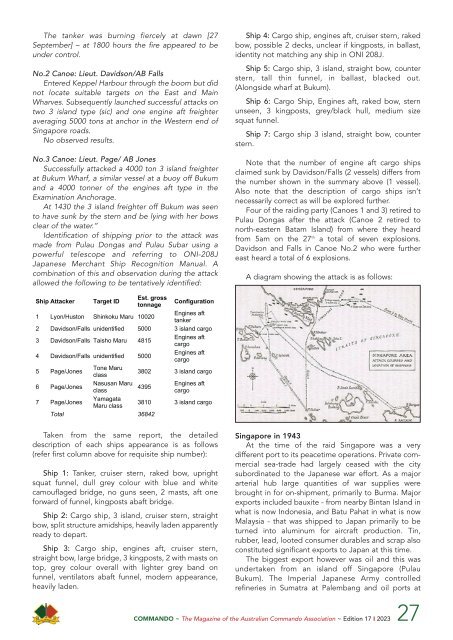Commando Edition 17 2023
The Official Commando News Magazine
The Official Commando News Magazine
You also want an ePaper? Increase the reach of your titles
YUMPU automatically turns print PDFs into web optimized ePapers that Google loves.
The tanker was burning fiercely at dawn [27<br />
September] – at 1800 hours the fire appeared to be<br />
under control.<br />
No.2 Canoe: Lieut. Davidson/AB Falls<br />
Entered Keppel Harbour through the boom but did<br />
not locate suitable targets on the East and Main<br />
Wharves. Subsequently launched successful attacks on<br />
two 3 island type (sic) and one engine aft freighter<br />
averaging 5000 tons at anchor in the Western end of<br />
Singapore roads.<br />
No observed results.<br />
No.3 Canoe: Lieut. Page/ AB Jones<br />
Successfully attacked a 4000 ton 3 island freighter<br />
at Bukum Wharf, a similar vessel at a buoy off Bukum<br />
and a 4000 tonner of the engines aft type in the<br />
Examination Anchorage.<br />
At 1430 the 3 island freighter off Bukum was seen<br />
to have sunk by the stern and be lying with her bows<br />
clear of the water.”<br />
Identification of shipping prior to the attack was<br />
made from Pulau Dongas and Pulau Subar using a<br />
powerful telescope and referring to ONI-208J<br />
Japanese Merchant Ship Recognition Manual. A<br />
combination of this and observation during the attack<br />
allowed the following to be tentatively identified:<br />
Ship 4: Cargo ship, engines aft, cruiser stern, raked<br />
bow, possible 2 decks, unclear if kingposts, in ballast,<br />
identity not matching any ship in ONI 208J.<br />
Ship 5: Cargo ship, 3 island, straight bow, counter<br />
stern, tall thin funnel, in ballast, blacked out.<br />
(Alongside wharf at Bukum).<br />
Ship 6: Cargo Ship, Engines aft, raked bow, stern<br />
unseen, 3 kingposts, grey/black hull, medium size<br />
squat funnel.<br />
Ship 7: Cargo ship 3 island, straight bow, counter<br />
stern.<br />
Note that the number of engine aft cargo ships<br />
claimed sunk by Davidson/Falls (2 vessels) differs from<br />
the number shown in the summary above (1 vessel).<br />
Also note that the description of cargo ships isn’t<br />
necessarily correct as will be explored further.<br />
Four of the raiding party (Canoes 1 and 3) retired to<br />
Pulau Dongas after the attack (Canoe 2 retired to<br />
north-eastern Batam Island) from where they heard<br />
from 5am on the 27 th a total of seven explosions.<br />
Davidson and Falls in Canoe No.2 who were further<br />
east heard a total of 6 explosions.<br />
A diagram showing the attack is as follows:<br />
Taken from the same report, the detailed<br />
description of each ships appearance is as follows<br />
(refer first column above for requisite ship number):<br />
Ship 1: Tanker, cruiser stern, raked bow, upright<br />
squat funnel, dull grey colour with blue and white<br />
camouflaged bridge, no guns seen, 2 masts, aft one<br />
forward of funnel, kingposts abaft bridge.<br />
Ship 2: Cargo ship, 3 island, cruiser stern, straight<br />
bow, split structure amidships, heavily laden apparently<br />
ready to depart.<br />
Ship 3: Cargo ship, engines aft, cruiser stern,<br />
straight bow, large bridge, 3 kingposts, 2 with masts on<br />
top, grey colour overall with lighter grey band on<br />
funnel, ventilators abaft funnel, modern appearance,<br />
heavily laden.<br />
Singapore in 1943<br />
At the time of the raid Singapore was a very<br />
different port to its peacetime operations. Private com -<br />
mercial sea-trade had largely ceased with the city<br />
subordinated to the Japanese war effort. As a major<br />
arterial hub large quantities of war supplies were<br />
brought in for on-shipment, primarily to Burma. Major<br />
exports included bauxite - from nearby Bintan Island in<br />
what is now Indonesia, and Batu Pahat in what is now<br />
Malaysia - that was shipped to Japan primarily to be<br />
turned into aluminum for aircraft production. Tin,<br />
rubber, lead, looted consumer durables and scrap also<br />
constituted significant exports to Japan at this time.<br />
The biggest export however was oil and this was<br />
undertaken from an island off Singapore (Pulau<br />
Bukum). The Imperial Japanese Army controlled<br />
refineries in Sumatra at Palembang and oil ports at<br />
COMMANDO ~ The Magazine of the Australian <strong>Commando</strong> Association ~ <strong>Edition</strong> <strong>17</strong> I <strong>2023</strong> 27
















